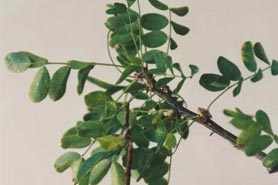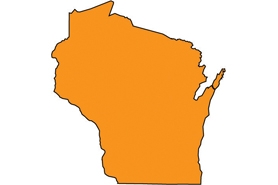Siberian peashrub
(Caragana arborescens)
Shrub or multi-stemmed tree in the pea family, with individual yellow flowers.
Other names for this plant include:
- Common names: Siberian pea tree, pea tree
- Scientific names: Caragana arborescens var. pendula; Caragana fruticosa; Caragana arborscens var. redowskii; Caragana sibirica; Robinia altagana var. fruticosa; Robinia caragana
Classification in Wisconsin: Restricted (cultivars Lorbergii, Pendula, and Walkerii are exempt)
- Ecological Threat
-
- Invades coniferous and hardwood forests, plantations, forest edges, savannas, trails, and right-of-ways.
- She is reportedly invasive throughout the Upper Midwest and Great Plains states.
- Extremely adaptable to a variety of soil conditions, salt and cold temperatures.
- It contains nitrogen-fixing microbial symbionts, altering natural soil chemistry and associated plant communities.
- Inhibits growth and establishment (allelopathic) of some grasses.
- Produces a chemical that reduces herbivore predation and pathogen establishment.
- Identification
-
Leaves & stems: Shrub or multi-stemmed tree. Alternate, pinnately compound leaves with 8-12 leaflets. Young leaflets are silky in texture, while mature leaflets are hairless. Tips of leaflets contain a spine.
Flowers: Yellow, singular flowers characteristic of the pea family. Flowers are fragrant and borne on long stalks.
Fruits & seeds: Seeds are in 1-2 inch pods, smooth and brown with sharply pointed tips. Pods eject seeds when they mature.
Roots: Nitrogen-fixing symbionts form nodules on the roots.
- Control
- Mechanical:
- Dig up individual plants. For larger populations, mow as close to the ground as possible. Continual mowing is needed as plants rapidly re-sprout.
- When leaves emerge, cover the infestation with black landscape fabric/plastic in early spring. Keep covered for a minimum of one growing season.
- Consecutive prescribed burns may be a successful control option, with sufficient fuel loads and fire-appropriate habitats.
- Cut-stump treatment with glyphosate.
- Cut-stump or basal bark treatments in fall with triclopyr.
- Resources
- Sources for content:
- Shortt, Katelyn B., Vamosi, Steven M. 2012. A review of the biology of the weedy Siberian pea shrub, Caragana arborescens, with an emphasis on its potential effects in North America. Botanical Studies, 53:1-8.
- Minnesota Department of Natural Resources
- National Park Service


